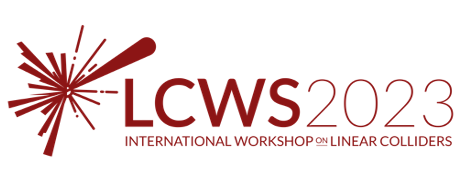Speaker
Description
A large, worldwide community of physicists is working to realize
an exceptional physics program of energy-frontier, electron-positron
collisions with the International Linear Collider (ILC)
and other collider projects (summarized and evaluated in
https://arXiv.org/abs/2208.06030).
The International Large Detector (ILD) is one of the proposed detector concepts at the next \ee collider. The ILD tracking system consists of a Si vertex detector, forward tracking disks, a large volume Time Projection Chamber (TPC) and silicon tracking detectors inside and outside of the TPC, all embedded in a 3.5 T solenoidal field. An extensive research and development program
for a TPC has been carried out within the framework of the LCTPC
collaboration. A Large Prototype TPC in a 1 T magnetic field, which allows
to accommodate up to seven identical Micropattern Gaseous Detector (MPGD)
readout modules of the TPC-design being studied, has been built as
a demonstrator at the 5 GeV electron test-beam at DESY. Three MPGD concepts
are being developed for the TPC: Gas Electron Multiplier, Micromegas and
Pixel, aslo known as GridPix, ($\equiv$ MicroMegas integrated on a Timepix chip).
Successful test beam campaigns with the different technologies have
been carried out during the last decade. Fundamental parameters such as transverse and longitudinal spatial resolution and drift velocity have been measured. In
parallel, a new gating device based on large-aperture GEMs has been
researched and successfully developed. Recent R\&D also led to a design of a
Micromegas module with monolithic cooling plate in 3D printing and 2-phase
CO2 cooling. In this talk, we will review the track reconstruction
performance results and summarize the next steps towards the TPC
construction for the ILD detector. The TPC with pad/(pixel) electronics is designed to have about 10$^6$ pads/ (10$^9$ pixels) per endcap for continuous tracking and a momentum resolution of ${\delta (1 / {p_t})}$~1$\times~$10$^{-4}$/GeV/c (TPC only)/({${\delta (1 / {p_t})}$~0.8$\times$~10$^{-4}$/GeV/c (60\% coverage, TPC only)}), and the dE/dx resolution is $\simeq 5$~\%/($\simeq 4$~\%). The momentum resolution including all tracking subdetectors is ~2~10$^{-5}$/GeV/c.



